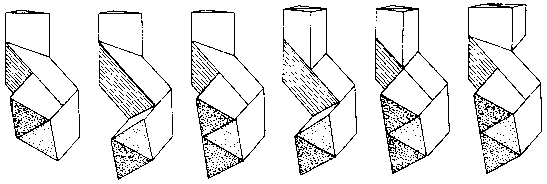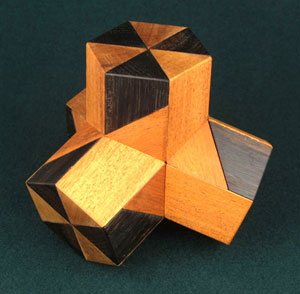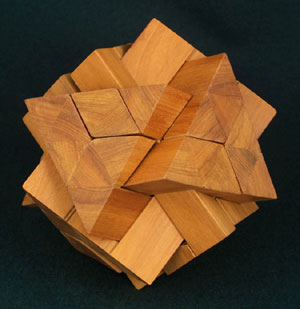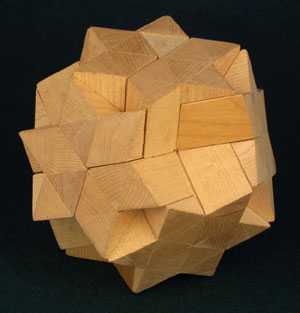 |
 |
 |
| Fig. 117 |
The Four Corners Puzzle, especially the augmented version, has rather the appearance of four mutually intersecting prisms. By use of triangular stick segments in the construction, this effect is accentuated to create some interesting sculptural shapes that are also enjoyable interlocking puzzles.
The first example shown in Fig. 117 is directly analogous to the Augmented Four Corners Puzzle and has the appearance of four mutually intersecting hexagonal prisms. The six dissimilar puzzle pieces assemble one way only with but one sliding axis. The triangular pattern in the hexagonal faces can be accentuated by using a contrasting wood for the permutated blocks.
By adding 12 more triangular stick segments to the Hexagonal Prism Puzzle, it is transformed into a most fascinating geometrical solid having the appearance of four mutually intersecting triangular prisms. With 42 blocks used in the construction, many design variations are possible depending upon how some of them are attached. One version having six dissimilar pieces is shown in Fig. 118.
By adding yet 12 more triangular stick segments to the Triangular Prism Puzzle, the prism faces assume the shape of the six-pointed Star of David. With 54 blocks used in the construction, a great many variations possible in the individual pieces, all having the assembled shape shown in Fig. 119.
Editor's Note: Stewart named this puzzle The General.
By adding even more blocks, other sculptural effects are possible, such as extending the prisms in the opposite directions as in the models illustrated in Fig. 120. Since these complicated constructions are more artistic than logical or mathematical, details are not given here but rather left to the craftsman's imagination.



Getting back to basics, at the ancestral root of all these strange non-rectilinear dissections is the venerable diagonal burr. An interesting variation of the diagonal burr is one using sticks having isosceles-right-triangular rather than square cross-section, as shown in Fig. 121. The six identical pieces assemble into an intriguing shape having the appearance of three mutually intersecting square columns. When well-crafted of three contrasting woods, the effect can be quite pleasing. As an assembly puzzle, it is so simple as to be almost trivial. But humble parents sometimes have precocious offspring.
Fig. 121
Now imagine each piece of the Square Prism Puzzle split in two longitudinally, resulting in 12 identical half-pieces. As an assembly puzzle, this additional dissection merely transforms it into more of a dexterity problem which is certainly not a step forward. But now join these half-pieces in perpendicular pairs - three right-handed and three left-handed. Now assemble! This amazing puzzle, shown in Fig. 122, with its six simple pieces has baffled experts. Even the name is a joke!
This puzzle was designed in 1973. Only about 200 have been produced, nearly all in mahogany. It is not difficult to make except that care is required to achieve an accurate fit, and stable woods must be used. The reader may wonder why it has not been mass-produced at low cost. Perhaps of injection-molded plastic, so that anyone may own one. That approach may not be such a good idea.
First of all there is no way that plastic can compete with wood aesthetically. Without arguing this point and the reasons for it, anyone who has sold handicrafts for a living knows that it is so. In toy manufacturing, the bottom line is usually profit and quarterly earnings, so puzzles are usually made of cheap styrene, warped by shrinkage, tapered slightly for easy ejection, and cored out to further reduce costs. To recover the investment in the mold, hundreds of thousands must be made exactly alike, whereas the designer-craftsman is always experimenting with variations and improvements. To reduce mold costs, compromises are made in design selection, especially avoiding those with all dissimilar pieces or requiring complicated moulds with side action. Also lost is the close rapport between designer and the public, when the manufacturer, jobber, and retailer all stand between. Perhaps some things, such as automobiles, are practical to manufacture only in large factories, but creative playthings crafted by hand are likely to bring more satisfaction to both maker and user.
Woodworking note
Many of the designs in this and the previous chapter consist of a basic skeleton of six identical interlocking parts to which are attached additional blocks, making the pieces dissimilar and non-symmetrical and the solution unique. These include the Broken Sticks Puzzle, Augmented Four Corners Puzzle, Diagonal Cube Puzzle, and all of the Prism family of puzzles above. The most satisfactory method for making any of these is to first make the six identical parts, assemble them tightly to form the skeleton and then glue the permutated blocks in the appropriate slots. This assures a perfect fit every time the puzzle is assembled. The Triangular Prism Puzzle is made by gluing the 12 additional stick segments onto an assembled Hexagonal Prism Puzzle, and so on, as suggested by the illustrations. Use wax or waxed paper to prevent accidental glue joints. The end faces of the Prism Puzzles are sanded true in the assembled state. More woodworking information is given in Chapter 23.